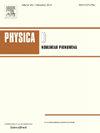Active Scalar mixing by homogeneous isotropic turbulence
IF 2.9
3区 数学
Q1 MATHEMATICS, APPLIED
引用次数: 0
Abstract
We study the mixing of active scalars by homogeneous isotropic incompressible stochastic velocity fields. We consider both Navier–Stokes generated turbulent fields as well as synthetically generated homogeneous isotropic stochastic fields. We use Fourier pseudospectral direct numerical simulations to study the mixing dynamics of two non-reacting species of different density ratios. We use the Atwood number to create a denser mixture and a lighter mixture. We show that in the absence of stirring, a denser mixture homogenizes faster than the lighter mixture. The direction of the density gradient causes the interface across which the molecular diffusion occurs to expand outward for the denser blob (lighter mixture) and inward for the lighter blob (denser mixture). The stirring process, which enhances the diffusion process, increases the rate of homogenization in both mixing methods under study. We define a new mixing metric for studying the mixing evolution of active scalars, which indicates that a denser inhomogeneity in a lighter mixture spreads faster but homogenizes slower. For low Mach number turbulence, there is a negligible coupling between the density gradients and the velocity field responsible for stirring. The post-stirring behavior of active scalars is found to be similar to passive scalars, where the scalar energy spectra decay exponentially and exhibit self-similarity. The turbulence fields generated by solving the Navier–Stokes equation homogenize both the mixtures faster than the synthetic cases. We show that matching the kinetic energy spectra and inertial subrange scaling of a synthetically generated stochastic field with that of a Navier–Stokes generated field is not enough to study mixing dynamics.
均匀各向同性湍流的主动标量混合
研究了均匀各向同性不可压缩随机速度场中活动标量的混合。我们既考虑了Navier-Stokes生成的湍流场,也考虑了综合生成的均匀各向同性随机场。采用傅立叶拟谱直接数值模拟方法研究了两种不同密度比的非反应物质的混合动力学。我们用阿特伍德数来制造一种密度更大的混合物和一种更轻的混合物。我们表明,在没有搅拌的情况下,较密的混合物比较轻的混合物均匀化得更快。密度梯度的方向导致分子扩散发生的界面向外扩展,对于密度较大的斑点(较轻的混合物),向内扩展,对于较轻的斑点(较密的混合物)。搅拌过程增强了扩散过程,提高了两种混合方式的均质率。我们定义了一个新的混合度量,用于研究活性标量的混合演化,表明在较轻的混合物中,密度较大的非均匀性传播更快,但均匀化较慢。对于低马赫数湍流,密度梯度和负责搅拌的速度场之间的耦合可以忽略不计。发现主动标量的搅拌后行为与被动标量相似,其中标量能谱呈指数衰减并表现出自相似性。通过求解Navier-Stokes方程产生的湍流场比合成情况下更快地使两种混合物均匀化。研究表明,将合成生成的随机场的动能谱和惯性子范围标度与纳维-斯托克斯生成场的动能谱和惯性子范围标度相匹配不足以研究混合动力学。
本文章由计算机程序翻译,如有差异,请以英文原文为准。
求助全文
约1分钟内获得全文
求助全文
来源期刊

Physica D: Nonlinear Phenomena
物理-物理:数学物理
CiteScore
7.30
自引率
7.50%
发文量
213
审稿时长
65 days
期刊介绍:
Physica D (Nonlinear Phenomena) publishes research and review articles reporting on experimental and theoretical works, techniques and ideas that advance the understanding of nonlinear phenomena. Topics encompass wave motion in physical, chemical and biological systems; physical or biological phenomena governed by nonlinear field equations, including hydrodynamics and turbulence; pattern formation and cooperative phenomena; instability, bifurcations, chaos, and space-time disorder; integrable/Hamiltonian systems; asymptotic analysis and, more generally, mathematical methods for nonlinear systems.
 求助内容:
求助内容: 应助结果提醒方式:
应助结果提醒方式:


